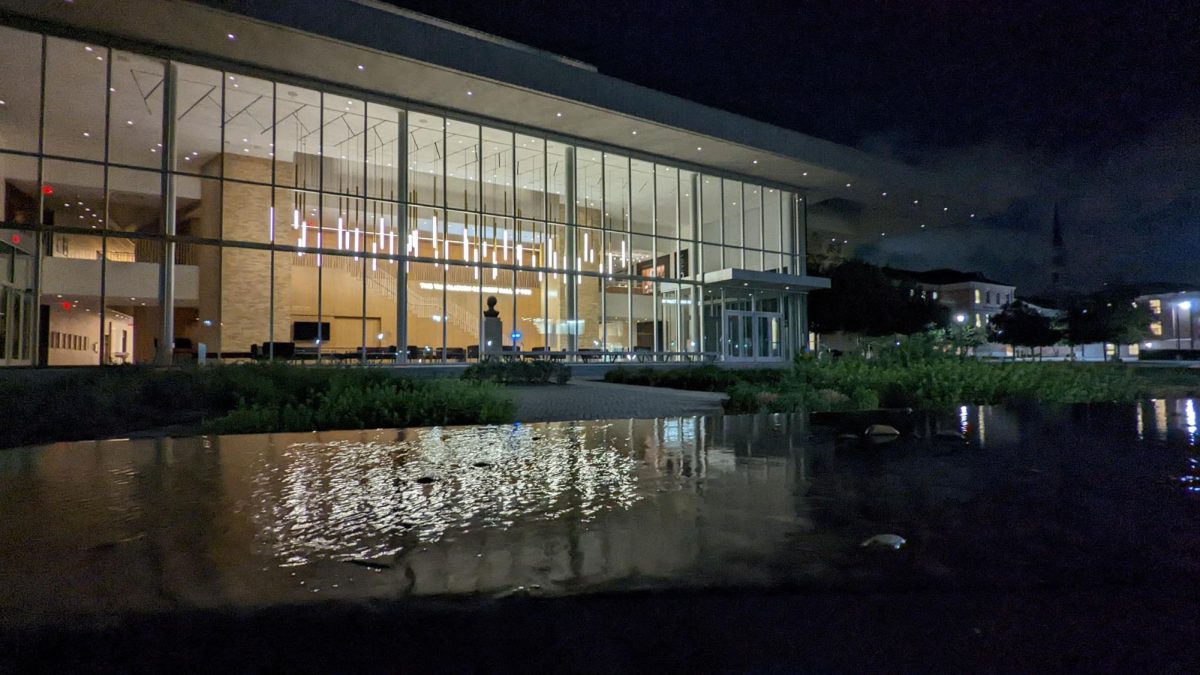It was a beautiful spring day with perfectly blue skies and a high of 91. But April 19, 2011, was just more evidence for the old saying: “If you don’t like the weather in Texas, wait five minutes.”
Ron Trumbla of the National Weather Service reported that DFW got .05 of an inch of rain on that particular day and a low temperature of 70.
In the 109, the brilliantly sunny day was interrupted by heavy, dark gray clouds, fat raindrops and quarter-sized hail at about 5:30 p.m. And then the sun came back out and dried the suddenly soaked streets of Fort Worth.
Anyone who’s lived in North Texas for a while knows just how quickly weather can change. And if everything’s bigger in Texas, the weather is no exception.
In the space of three days, the weather can go from sunny highs in the 80s and 90s to rainy with a high around 50 degrees. May 2, 2011 set a record for the lowest recorded maximum temperature for that day.
Victor Murphy, a National Weather Service representative, said the spring is the prime time for crazy Texas weather. Most rapidly developing storms and severe weather occur in April and May.
Murphy, a native of Miami, Fla., will never forget his first run-in with North Texas weather.
He had lived in North Texas a mere two months before the Mayfest hailstorm hit on May 5, 1995, while he was shopping at Ridgmar Mall.
“I don’t think I’ve ever seen hailstones that big,” Murphy said.
Murphy recalled watching hailstones punch through back windshields into the trunks of cars.
During the event, softball-sized hail fell across the Western half of Fort Worth damaging cars, roofs and other property, Murphy said.
“Half of the west side of Fort Worth got new roofs out of that storm,” Murphy said.
Murphy added that North Texas falls in the perfect location for severe storm development where large air masses meet.
None of the weather found in this area is unique. What makes it unique is the combination of the various weather phenomena that plague North Texas residents, said Mike Slattery, director of the Institute for Environmental Studies at TCU.
Slattery, a professor of environmental science, said the unique geography of the area that stretches from North Texas to Kansas contributes to its unique weather conditions.
“What’s really interesting about this part of the world is its geography in general sets us up for a really broad scope of weather both severe and non-severe,” Slattery said. “And I guess what it comes down to is it really serves up an incredible smorgasbord of weather phenomena here because of the variability in the driving mechanisms that we have here.”
Its proximity to the Gulf of Mexico and the Mexican Plateau as well as its location on the Southern Plains puts it in the perfect location to experience everything from hurricanes to snowstorms, Slattery said.
“It’s not Honolulu where you’re out in the middle of the ocean and you’ve basically got high humidity and prevailing winds in the tropics and it’s a high of 88 and a low of 80, and come back tomorrow kind of thing,” Slattery said.
That fact was confirmed by Murphy, the climate service program manager for the National Weather Service’s Southern Region.
“We can totally run the entire gamut here over a very short period of time,” Murphy said. “As opposed to a lot of other parts of the country, which do not see that kind of variability: that kind of rapid change. For example in Florida this kind of stuff is almost unheard of because you have the oceans nearby you, which moderates things a heck of a lot.”
North Texas weather may be unique, but it’s not native only to North Central Texas – it also stretches all along the I-35 corridor from Fort Worth to Oklahoma City or as far north as Wichita, Kan., Murphy said.
For Murphy, the most important thing for residents to know about severe weather is to have a plan for dealing with it. Wherever residents or visitors may go in North Texas, they should check weather reports and make plans accordingly.
On days when severe weather is in the forecast, 109ers should try to stay indoors. Even the increased accuracy of storm-based warnings cannot predict secondary storm development and do not accurately predict the long-term storm movement.
But it’s difficult to decide what to do when it’s the house that needs to take cover as is the case during flood events.
There’s little we can do as residents on an individual level to abate flooding when waters rise quickly during spring thunderstorms, but Slattery said there are some things residents can do to help decrease flooding even in urban areas like Fort Worth.
The problem in cities is with increased runoff from the greater percentage of surfaces that can’t absorb rainwater.
On a larger scale, the city can consider rain collection barrels and permeable pavement that would allow water to reach the soil underneath, but residents can help by populating their lawns with materials and plants that help get the water into the soil.
In 2007, the National Weather Service introduced the storm-based warning system that more accurately pinpoints the location of tornados, floods and severe thunderstorms, but Murphy said this system only works on a very short-term basis. He advised that residents remain vigilant and be prepared for the possibility for severe weather any time it is spotted in the area.
According to the National Oceanic and Atmospheric Administration, the organization implemented the storm-based warning system to help direct first responders who would pre-position themselves nearest the danger as well as decrease the unnecessary retreat into secure locations for those less likely to be affected.
Under the previous system, the entire county was placed under a warning, which many residents would ignore because of the decreased chance that a warning applied to their specific area. The new system is more precise, using roads and portions of counties to identify the danger areas, and allows the National Weather Service to alert those most likely to be affected by the storm to take cover in the event of a tornado.
The warnings decrease the amount of residents unnecessarily taking cover and increase the likelihood that warnings will be taken seriously when issued.
Mike Slattery’s Dos and Don’ts of severe weather
Texas is in the perfect position for severe weather development because of the combination of warm, moist air from the Gulf of Mexico, cooler, drier air from the interior of the U.S. and hot, dry air from the Mexican Plateau.
Bad weather develops rapidly and often, especially during the spring. Residents should prepare themselves by knowing what to do and what not to do in a severe weather situation.
Don’t:
• Open windows to correct a pressure difference if a tornado is coming, this will just create the even bigger problem of flying glass and other debris. “Yes, there is a pressure difference on the outside and the inside of the building but that changes so rapidly because of the strength of the winds that it blows that glass out.”
• Get in a car and attempt to outrun a tornado. They move quickly, so the chance of outrunning one is slim compared to the chance of getting picked up by one and tossed in the opposite direction.
• Stay in a mobile home. They were designed to move, and tornados love to pick them up and toss them aside.
• Go outside to see what’s happening.
• Stand under a tree during a lightning storm.
• Get out of the car and run under a highway bridge. These areas simply funnel flying debris and increase the chances of being injured.
Do:
• Get inside as quickly as you can.
• Get into any part of your home closest to the interior of the home with no windows and get under a mattress or something solid to protect you from flying debris.
• Keep a weather radio at your home to alert you to severe weather in your area.
• Keep water, flashlights, a first aid kit and your weather radio in a safe, obvious place near the location where you would take cover. “It’s a source of comfort when they’re there and you know that ‘OK, if something goes wrong and we lose power, I can get my ha





